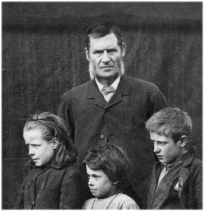|
Whilst researching Family History
in Scotland, there are a number of concepts and
issues we feel you should bear in mind:
Timescale
Genealogy is not a quick process.
Do not expect to produce an accurate family tree
with a couple of hours' work on the Web or with
one visit to an archive. Some genealogists spend
decades exhausting all the sources of information
about their ancestors, others spend a couple of
weeks' vacation researching several lines of the
family tree.
Hitting the wall at 1800
Most researchers find it relatively
straightforward to trace Scottish ancestry back
to the decades either side of 1800. From there
the going gets tough and many family historians
either stop at this point or widen out their search
to include other lines or gather more information
about what life was like for their ancestors.
Clans and tartans
Many people are inspired to
begin tracing Scottish ancestry by their desire
to belong to a 'clan' - as portrayed in film and
folklore. However, the idea that a clan consists
of everyone with the same Scottish surname, entitled
to wear the same tartan, is a modern one. The
development of this popular image of clans and
tartans is itself part of our national history;
and it was recently summarised in C Withers, 'The
Historical Creation of the Scottish Highlands',
a chapter in I Donnachie and C Whatley (eds.),
The Manufacture of Scottish History (Edinburgh,
1992). A full definition of clan society can be
found in A I Macinnes, Clanship, Commerce and
the House of Stuart, 1603-1788 (East Linton,
1996); and the disintegration of clan society
and the subsequent development of Highland society
is discussed in several chapters of T M Devine,
The Scottish Nation 1700-2000 (London,
1999)
Family myths
Family traditions of what ancestors
did and who they were related to often turn out
to be exaggerations, while others are simply impossible
of being validated from historical records. Approach
family history with an open mind and be prepared
for family traditions to be exposed as myths.
|
Emigration records emigrate
Do not expect to find centrally
or locally held records of emigrants in Scotland
itself. Passenger lists invariably went with the
passengers and ended up in the country of arrival
(although the Public Record Office in London holds
passenger lists from 1890 onwards for British
ports). Further information about emigration from
Scotland is available in the SCAN Knowledge Base.
Parishes and counties
In the period you will be searching
for Scottish ancestors Scotland was divided into
33 counties and over 900 parishes. Many of the
records you will use will be arranged by county
and/or parish name. Advice on how to convert a
place name to a parish and county will follow
on this site soon. Register, and we'll keep you
up to date with developments.
Digging for graves
Of the three main 'life events'
(births, marriages and deaths), deaths, and in
particular where a burial took place, is the hardest
to research, especially before municipal cemeteries
were established in the second half of the 19th
century. Expect to be frustrated in many cases
when trying to find where the remains of an ancestor
now repose.

A family appearing before the
Glasgow Juvenile Delinquency Board, 1886 Reproduced
with permission of Glasgow City Archives.
|